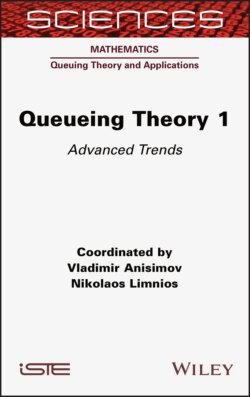Читать книгу Queueing Theory 1 - Nikolaos Limnios - Страница 23
1.4.1. Preliminaries
ОглавлениеDefine a K × M matrix EKM such that its elements have values of 0 or 1 and in addition
– for K ≥ M, we require that and ;
– for K ≤ M, we require that , and
Next we define a stochastic vector ψ =[ψ1, ψ2, ... ,ψK], which is a function of s, i.e. ψ = f(s), where f : RM → RK. We give some very simple examples of this type of mapping.
– Consider the case when K = M. A simple mapping of f could be ψi = si, ∀i, i.e.ψ = s. Another possible example could be . Finally, we could generate ψ from s using any argument possible, as long as ψ depends on s. For this simple example alone, there are K! ways of generating the mapping by rearranging the elements of ψ, if we keep the values of si unchanged, e.g.
– There are two possible cases when K ≠ M.- Consider the case where K < M, an example of the mapping here could beas an example only, and- for the case of K > M, an example of the mapping here could beagain just an example.
The K interarrival times can each be written as PH distribution (α(k), T(k)), where k = 1,2, ..., K. Hence the resulting interarrival time, which is a function of the service time, is a PH distribution represented by where
where α = [α(1), α(2), ∙∙∙ , α(k)] and the operator * is the Khatri-Rao (K-R) product (Khatri and Rao 1968) , and here we have
In applying K-R operator, here the first vector ψ is partitioned into K, 1 × 1 vectors, i.e. into scalars in order to properly apply the K-R operator.
This is better illustrated with an example.
Example
Consider a case of a service time S with i.e.M = 4. Let K = 3, with the three interarrival PH distributions given as (α(k), T(k)), k = as an example.
Then we have a system with service time distribution vector given as s = [s1, s2, s3, s4] and interarrival time distribution given as a PH with
Numerical examples
Let s =[0.1, 0.3, 0.4, 0.2] and
suppose we select three mappings of s with We can then generate two PH distributions that are both dependent on s, but with different mappings with both having the same T given as follows
but different .
Let Aj be the interarrival times for the jth mapping and . Table 1.2 summarizes the results.
Table 1.2. Complementary Cumulative distributions of interarrival times
| k | 1 | 2 | 3 | 4 | 5 | 6 | 7 | 8 | 9 |
|---|---|---|---|---|---|---|---|---|---|
| P1(k) | 0.6490 | 0.4886 | 0.3311 | 0.2382 | 0.1704 | 0.1246 | 0.0919 | 0.688 | 0.0522 |
| P2(k) | 0.7110 | 0.5526 | 0.4225 | 0.3361 | 0.2705 | 0.2210 | 0.1823 | 0.1516 | 0.1268 |
| P3(k) | 0.6740 | 0.5128 | 0.3657 | 0.2751 | 0.2084 | 0.1613 | 0.1265 | 0.1006 | 0.0810 |
In future works, we study how the different arrangements of s affect the features and distribution and moments of the interarrival times. This can be used to show how one can control the arrival process and hence the queue performance by using different selections of the vector s.
